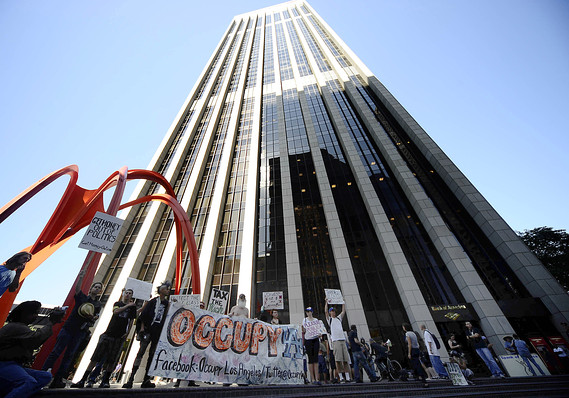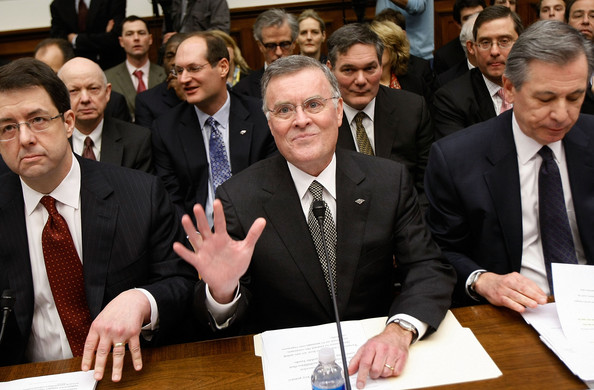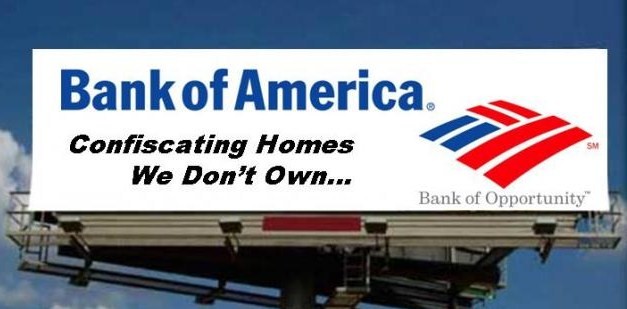William Black: Not With A Bang, But A Whimper: Bank Of America’s Derivatives Death Rattle

BAC continues to deteriorate and the credit rating agencies have been downgrading it because of its bad assets, particularly its derivatives. BAC’s answer is to “transfer” the bad derivatives to the insured bank – transforming (ala Ireland) a private debt into a public debt. (Photo - Bank of America San Francisco Headquarters)
Background coverage of this story can be found here:
---
Guest post by William K. Black
Bob Ivry, Hugh Son and Christine Harper have written an article that needs to be read by everyone interested in the financial crisis. The article (available here) is entitled: BofA Said to Split Regulators Over Moving Merrill Derivatives to Bank Unit. The thrust of their story is that Bank of America’s holding company, BAC, has directed the transfer of a large number of troubled financial derivatives from its Merrill Lynch subsidiary to the federally insured bank Bank of America (BofA). The story reports that the Federal Reserve supported the transfer and the Federal Deposit Insurance Corporation (FDIC) opposed it. Yves Smith of Naked Capitalism has written an appropriately blistering attack on this outrageous action, which puts the public at substantially increased risk of loss.
I write to add some context, point out additional areas of inappropriate actions, and add a regulatory perspective gained from dealing with analogous efforts by holding companies to foist dangerous affiliate transactions on insured depositories. I’ll begin by adding some historical context to explain how B of A got into this maze of affiliate conflicts.
Ken Lewis’ “Scorched Earth” Campaign against B of A’s Shareholders
Acquiring Countrywide: the High Cost of CEO Adolescence
During this crisis, Ken Lewis went on a buying spree designed to allow him to brag that his was not simply bigger, but the biggest. Bank of America’s holding company – BAC – became the acquirer of last resort. Lewis began his war on BAC’s shareholders by ordering an artillery salvo on BAC’s own position. What better way was there to destroy shareholder value than purchasing the most notorious lender in the world – Countrywide. Countrywide was in the midst of a death spiral. The FDIC would soon have been forced to pay an acquirer tens of billions of dollars to induce it to take on Countrywide’s nearly limitless contingent liabilities and toxic assets. Even an FDIC-assisted acquisition would have been a grave mistake. Acquiring thousands of Countrywide employees whose primary mission was to make fraudulent and toxic loans was an inelegant form of financial suicide. It also revealed the negligible value Lewis placed on ethics and reputation.
But Lewis did not wait to acquire Countrywide with FDIC assistance. He feared that a rival would acquire it first and win the CEO bragging contest about who had the biggest, baddest bank. His acquisition of Countrywide destroyed hundreds of billions of dollars of shareholder value and led to massive foreclosure fraud by what were now B of A employees.
But there are two truly scary parts of the story of B of A’s acquisition of Countrywide that have received far too little attention. B of A claims that it conducted extensive due diligence before acquiring Countrywide and discovered only minor problems. If that claim is true, then B of A has been doomed for years regardless of whether it acquired Countrywide. The proposed acquisition of Countrywide was huge and exceptionally controversial even within B of A. Countrywide was notorious for its fraudulent loans. There were numerous lawsuits and former employees explaining how these frauds worked.
B of A is really “Nations Bank” (formerly named NCNB). When Nations Bank acquired B of A (the San Francisco based bank), the North Carolina management took complete control. The North Carolina management decided that “Bank of America” was the better brand name, so it adopted that name. The key point to understand is that Nations/NCNB was created through a large series of aggressive mergers, so the bank had exceptional experience in conducting due diligence of targets for acquisition and it would have sent its top team to investigate Countrywide given its size and notoriety. The acquisition of Countrywide did not have to be consummated exceptionally quickly. Indeed, the deal had an “out” that allowed B of A to back out of the deal if conditions changed in an adverse manner (which they obviously did). If B of A employees conducted extensive due diligence of Countrywide and could not discover its obvious, endemic frauds, abuses, and subverted systems then they are incompetent. Indeed, that word is too bloodless a term to describe how worthless the due diligence team would have had to have been. Given the many acquisitions the due diligence team vetted, B of A would have been doomed because it would have routinely been taken to the cleaners in those earlier deals.
That scenario, the one B of A presents, is not credible. It is far more likely that B of A’s senior management made it clear to the head of the due diligence review that the deal was going to be done and that his or her report should support that conclusion. This alternative explanation fits well with B of A’s actual decision-making. Countrywide’s (and B of A’s)reported financial condition fell sharply after the deal was signed. Lewis certainly knew that B of A’s actual financial condition was much worse than its reported financial condition and had every reason to believe that this difference would be even worse at Countrywide given its reputation for making fraudulent loans. B of A could have exercised its option to withdraw from the deal and saved vast amounts of money. Lewis, however, refused to do so. CEOs do not care only about money. Ego is a powerful driver of conduct, and CEOs can be obsessed with status, hierarchy, and power. Of course, Lewis knew he could walk away wealthy after becoming a engine of mass destruction of B of A shareholder value, so he could indulge his ego in a manner common to adolescent males.
Acquiring Merrill Lynch: the Lure of Liar’s Loans
Merrill Lynch is the quintessential example of why it was common for the investment banks to hold in portfolio large amounts of collateralized debt obligations (CDOs). Some observers have jumped to the naïve assumption that this indicates that the senior managers thought the CDOs were safe investments. The “recipe” for an investor maximizing reported income differs only slightly from the recipe for lenders.
- Grow rapidly by
- Holding poor quality assets that provide a premium nominal yield while
- Employing extreme leverage, and
- Providing only grossly inadequate allowances for future losses on the poor quality assets
Investment banks that followed this recipe (and most large U.S. investment banks did), were guaranteed to report record (albeit fictional) short-term income. That income was certain to produce extreme compensation for the controlling officers. The strategy was also certain to produce extensive losses in the longer term – unless the investment bank could sell its losing position to another entity that would then bear the loss.
The optimal means of committing this form of accounting control fraud was with the AAA-rated top tranche of CDOs. Investment banks frequently purport to base compensation on risk-adjusted return. If they really did so investment bankers would receive far less compensation. The art, of course, is to vastly understate the risk one is taking and attribute short-term reported gains to the officer’s brilliance in achieving supra-normal returns that are not attributable to increased risk (“alpha”). Some of the authors of Guaranteed to Fail call this process manufacturing “fake alpha.”
The authors are largely correct about “fake alpha.” The phrase and phenomenon are correct, but the mechanism they hypothesize for manufacturing fake alpha has no basis in reality. They posit honest gambles on “extreme tail” events likely to occur only in rare circumstances. They provide no real world examples. If risk that the top tranche of a CDO would suffer a material loss of market values was, in reality, extremely rare then it would be impossible to achieve a substantial premium yield. The strategy would diminish alpha rather than maximizing false alpha. The risk that the top tranche of a CDO would suffer a material loss in market value was highly probable. It was not a tail event, much less an “extreme tail” event. CDOs were commonly backed by liar’s loans and the incidence of fraud in liar’s loans was in the 90% range. The top tranches of CDOs were virtually certain to suffer severe losses as soon as the bubble stalled and refinancing was no longer readily available to delay the wave of defaults. Because liar’s loans were primarily made to borrowers who were not creditworthy and financially unsophisticated, the lenders had the negotiating leverage to charge premium yields. The officers controlling the rating agencies and the investment banks were complicit in creating a corrupt system for rating CDOs that maximized their financial interests by routinely providing AAA ratings to the top tranche of CDOs “backed” largely by fraudulent loans. The combination of the fake AAA rating and premium yield on the top tranche of fraudulently constructed (and sold) CDOs maximized “fake alpha” and made it the “sure thing” that is one of the characteristics of accounting control fraud (see Akerlof & Romer 1993; Black 2005). This is why many of the investment banks (and, eventually, Fannie and Freddie) held substantial amounts of the top tranches of CDOs. (A similar dynamic existed for lower tranches, but investment banks also found it much more difficult to sell the lowest tranches.)
Merrill Lynch was known for the particularly large CDO positions it retained in portfolio. These CDO positions doomed Merrill Lynch. B of A knew that Merrill Lynch had tremendous losses in its derivatives positions when it chose to acquire Merrill Lynch.
Given this context, only the Fed, and BAC, could favor the derivatives deal
Lewis and his successor, Brian Moynihan, have destroyed nearly one-half trillion dollars in BAC shareholder value. (See my prior post on the “Divine Right of Bank Profits…”) BAC continues to deteriorate and the credit rating agencies have been downgrading it because of its bad assets, particularly its derivatives. BAC’s answer is to “transfer” the bad derivatives to the insured bank – transforming (ala Ireland) a private debt into a public debt.
Banking regulators have known for well over a century about the acute dangers of conflicts of interest. Two related conflicts have generated special rules designed to protect the bank and the insurance fund. One restricts transactions with senior insiders and the other restricts transactions with affiliates. The scam is always the same when it comes to abusive deals with affiliates – they transfer bad (or overpriced) assets or liabilities to the insured institution. As S&L regulators, we recurrently faced this problem. For example, Ford Motor Company attempted to structure an affiliate transaction that was harmful to the insured S&L (First Nationwide). The bank, because of federal deposit insurance, typically has a higher credit rating than its affiliate corporations.
BAC’s request to transfer the problem derivatives to B of A was a no brainer – unfortunately, it was apparently addressed to officials at the Fed who meet that description. Any competent regulator would have said: “No, Hell NO!” Indeed, any competent regulator would have developed two related, acute concerns immediately upon receiving the request. First, the holding company’s controlling managers are a severe problem because they are seeking to exploit the insured institution. Second, the senior managers of B of A acceded to the transfer, apparently without protest, even though the transfer poses a severe threat to B of A’s survival. Their failure to act to prevent the transfer contravenes both their fiduciary duties of loyalty and care and should lead to their resignations.
Now here’s the really bad news. First, this transfer is a superb “natural experiment” that tests one of the most important questions central to the health of our financial system. Does the Fed represent and vigorously protect the interests of the people or the systemically dangerous institutions (SDIs) – the largest 20 banks? We have run a real world test. The sad fact is that very few Americans will be surprised that the Fed represented the interests of the SDIs even though they were directly contrary to the interests of the nation. The Fed’s constant demands for (and celebration of) “independence” from democratic government, combined with slavish dependence on and service to the CEOs of the SDIs has gone beyond scandal to the point of farce. I suggest organized “laugh ins” whenever Fed spokespersons prate about their “independence.”
Second, I would bet large amounts of money that I do not have that neither B of A’s CEO nor the Fed even thought about whether the transfer was consistent with the CEO’s fiduciary duties to B of A (v. BAC). We took depositions during the S&L debacle in which senior officials of Lincoln Savings and its affiliates were shocked when we asked “whose interests were you representing – the S&L or the affiliate?” They had obviously never even considered their fiduciary duties or identified their actual client. We blocked a transaction that would have caused grave injury to the insured S&L by taking the holding company (Pinnnacle West) off the hook for its obligations to the S&L. That transaction would have passed routinely, but we flew to the board of directors meeting of the S&L and reminded them that their fiduciary duty was to the S&L, that the transaction was clearly detrimental to the S&L and to the benefit of the holding company, and that we would sue them and take the most vigorous possible enforcement actions against them personally if they violated their fiduciary duties. That caused them to refuse to approve the transaction – which resulted in a $450 million payment from the holding company to the S&L. (I know, $450 million sounds quaint now in light of the scale of the ongoing crisis, but back then it paid for our salaries in perpetuity.)
Third, reread the Bloomberg column and wrap your mind around the size of Merrill Lynch’s derivatives positions. Next, consider that Merrill is only one, shrinking player in derivatives. Finally, reread Yves’ column in Naked Capitalism where she explains (correctly) that many derivatives cannot be used safely. Add to that my point about how they can be used to create a “sure thing” of record fictional profits, record compensation, and catastrophic losses. This is particularly true about credit default swaps (CDS) because of the grotesque accounting treatment that typically involves no allowances for future losses. (FASB: you must fix this urgently or you will allow a “perfect crime.”). It is insane that we did not pass a one sentence law repealing the Commodities Futures Modernization Act of 2000. Between the SDIs, the massive, sometimes inherently unsafe and largely opaque financial derivatives, the appointment, retention, and promotion of failed anti-regulators, and the continuing ability of elite control frauds to loot with impunity we are inviting recurrent, intensifying crises.
I’ll close with a suggestion and request to reporters. Please find out who within the Fed approved this deal and the exact composition of the assets and liabilities that were transferred.
William K. Black, J.D., Ph.D. is Associate Professor of Law and Economics at the University of Missouri-Kansas City. He is also the author of the book "The Best Way to Rob a Bank is to Own One."
© 2011 New Economic Perspectives



 Oct 19, 2011 at 3:02 PM
Oct 19, 2011 at 3:02 PM
Reader Comments (7)
The analyst sent this note to clients earlier:
…Finally, while we entered a question to ask on the conference call (confirmed by the operator), BAC ended the call without taking our question and closed the call by saying, “We have no further questions at this time.” This action by the company appears to us to be more insular than they have acted in the past, and diminishes our trust and confidence in the results they presented – even if the shares are trading up 7% post call.
POLL: What are your thoughts on Bank of America moving derivatives from Merrill Lynch?
Vote: http://www.wepolls.com/p/4316351
The Fed successfully transferred Merrill's bad debts to the shareholders of B of A. Perhaps it now continues by transferring it to the FDIC and ultimately the taxpayers? Different perspective.
Now if this was the case, the following outlandish scenario shows just how far down the rabbit hole of lawlessness we've gone:
Many charities have been put on terrorist lists for less cause than the derivatives bazooka the Fed has just aimed at us. There is now no legal nicety that would prevent the President from declaring it so, detaining Paulson and Bernanke indefinitely and without charges and waterboarding them to find out....no?